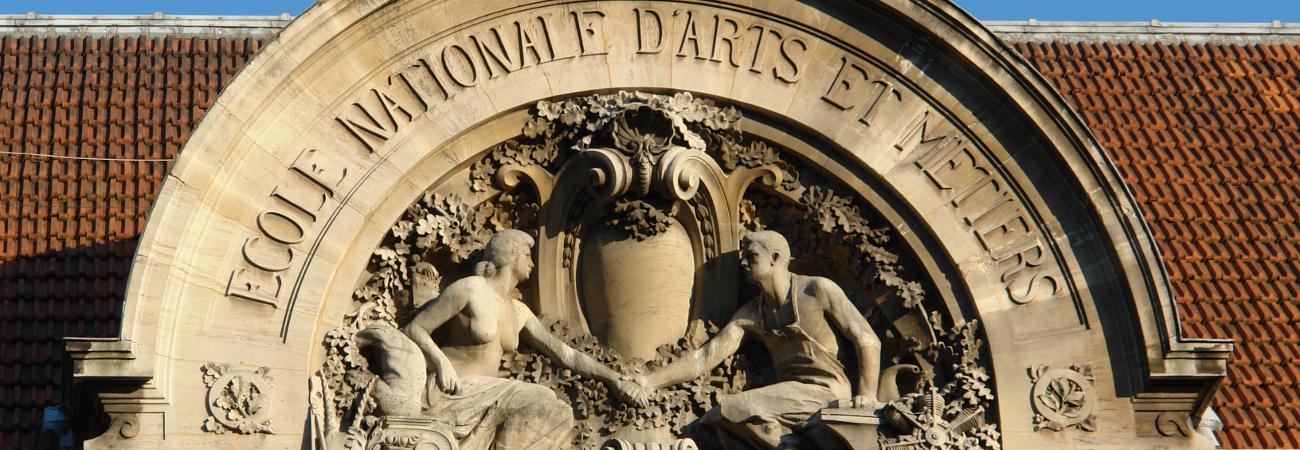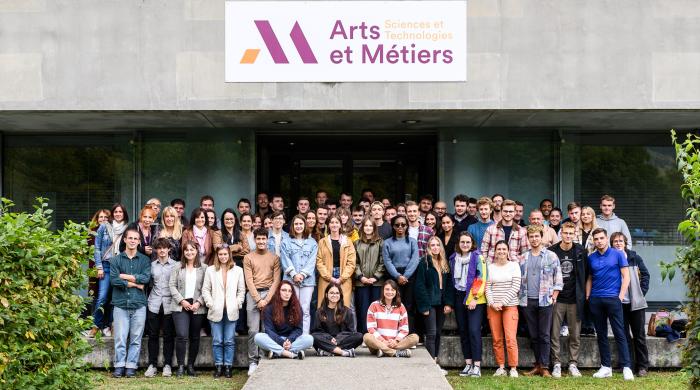
Founded in 1780, Arts et Métiers is the third oldest Engineering School in France.
History
The school was founded in Liancourt, Oise, by Duke of Rochefoucauld-Liancourt in 1780; it was originally meant to provide in-depth training for military officers children.
After 1800, the institution became known as the École d'Arts et Métiers.
Under Napoleon's reign, it was known as the "Ecole impériale des Arts et Métiers". He intended to use the school to train "Non-commissioned officers of Industry". The empire decided to move the school to a bigger city, Compiègne, in 1799. When Napoléon Bonaparte visited the castle where the school was located, he thought that it was inappropriate for such an industrial school to occupy the place. He decided to relocate the school to Châlons-en-Champagne in 1806, where two former monasteries were made available to offer much more space.
Many students and alumni enlisted in the armed forces during the World War I. It is estimated that of the 6500 gadzarts (Arts et Métiers engineers) who joined the army, 1100 died the first year of the conflict. Many campuses were damaged by the war, especially that of Châlons-sur-Marne, which was in the middle of the Battle of the Marne. The Lille campus was occupied by the Germans and used as a military hospital. The other campuses were completely closed from 1916–17 and the new Parisian campus was undamaged.
Between the wars, the rapid industrialization of Europe favoured the Gadzarts. The arms race pushed industry to hire more engineers and the gadzarts matched their needs perfectly. The other important factor was the creation of new ranks in the hierarchical working organization. The middle management and upper management positions were perfect for the gadzarts engineers who rapidly filled these positions in most industries; especially automotive, aeronautical and construction.
During World War II , the school tried to keep a certain level of activity. The only campuses to experience some difficulties were Lille and Châlons-sur-Marne: in 1939 no new students were admitted. The Cluny campus was the target of a roundup in 1943 and a large part of students and staff were deported. The death of Jacques Bonsergent left a mark on the conflict, he became a symbol of resistance to the oppressor.
The second school of this kind was founded in 1804 at Beaupréau and then transferred to Angers in 1815. Three decades later, a third school was built in Aix-en-Provence in 1843, in former barracks and monasteries.
At the dawn of the 20th century, the development of the school expanded to three new campuses. In 1891, the ancient abbey of Cluny was chosen to host the activities of the 4th school. Then, to go hand in hand with the industrial revolution, the members of parliament decided to create a 5th campus in Lille, a city that was rapidly growing. The facilities of Lille were the first ones to be built expressly for the school. The campus of Paris, a long-standing project, was built between 1906 and 1912. It became the biggest campus of the Arts et Métiers but World War II delayed the school's opening. By the end of the war, the campus had over 500 students.
In the middle of the "Trentes Glorieuses" (the Glorious Thirty), the 7th campus was created near Bordeaux, in the science park of Talence. The modern buildings were operational in 1963.
The latest campus established was Metz (1997). The campus was built in the science park, close to the transportation hubs. The school wanted this campus to become an international one, being close to Belgium, Luxembourg and Germany. Its construction was also motivated by partnerships with German (KIT) and American (Georgia Tech) universities.
Between 1990 and 2000, the 3 institutes of research were created : Chambéry in 1994, Chalon-sur-Saône in 1997 and Laval.
Traditions
Gadz'Arts or Gadzarts is the nickname given to the students and the alumni of Arts et Métiers.
Since the beginning of the institution, the students of the school perpetuate their own traditions and folklore, and organise themselves in a student society or union. They call themselves "Gadz'Arts", abbreviated from "Gars des Arts" ("Guys from the Arts", the school's nickname is the "Arts"). The "Gadz" folklore includes traditional clothing, slang, songs and legends, related symbolism, and ceremonials.
The Gadz'Arts community is proud of its ancient traditions which are based on the values of mutual aid and fraternity as well as on the oral memory of numerous anecdotes and songs connected to the history of the school.
In school, the pupils wear a lab coat (named a "biaude" in Argad'z language). It is traditionally grey for the first and second year students - white ones are reserved for those in their last year of study. Gadz'Arts customize their coats individually. The coats of the first year students are generally rather sombre and plain; whilst those of the second and third year students often have elaborate coloured motifs and drawings.
Gadz'Arts also possess a uniform (nicknamed a 'Zag' in Argad'z), a nod to their military past. It is navy blue in colour and very close to the uniform of the officers of French Marine.
When they enter the school, the students are given nickname, called a "bucque", that they use afterward in their relations with the other students and alumni.
Each student is the "ancient" of one student of the following class and the "parrain" (or godfather) of one student of the class coming 25 years after. This creates continuity, which is the root of long term relations that last long after the students have left the school. It is called a family.
One redundant and certainly the most important of gadz imagery/symbol is the square:
- It is one of the most important instruments for a mechanical engineer.
- It is a symbol for probity, a motto of the school's founder Duke of Rochefoucauld-Liancourt: "Helping with all that is useful, attaching his name to all that is right."
- It refers to the alleged historical link between the school and Compagnons du Tour de France.



